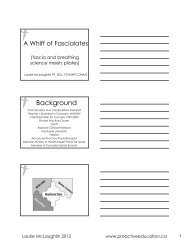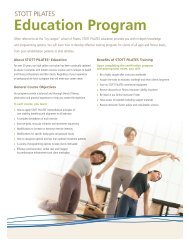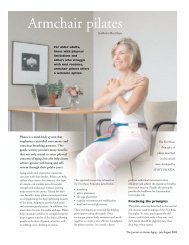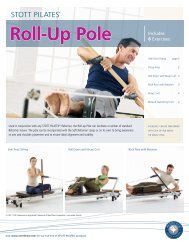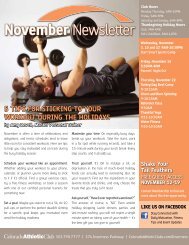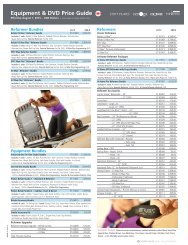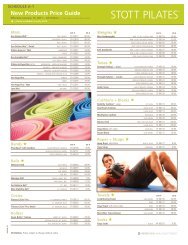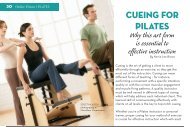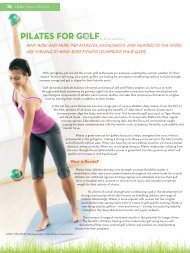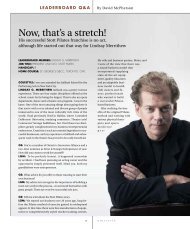Download STOTT PILATES® Five Basic Principles - Merrithew.com
Download STOTT PILATES® Five Basic Principles - Merrithew.com
Download STOTT PILATES® Five Basic Principles - Merrithew.com
You also want an ePaper? Increase the reach of your titles
YUMPU automatically turns print PDFs into web optimized ePapers that Google loves.
<strong>STOTT</strong> PILATES ®<br />
FIVE BASIC PRINCIPLES<br />
Using Contemporary Pilates <strong>Principles</strong> to Achieve Optimal Fitness<br />
By Moira <strong>Merrithew</strong>, <strong>STOTT</strong> PILATES ® Executive Director, Education<br />
The aim of contemporary, anatomically-based Pilates training, such as <strong>STOTT</strong> PILATES, ® is to develop optimal neuromuscular<br />
performance by focusing on core stability, while safely balancing muscular strength with flexibility. Whether performed on a mat<br />
or on specialized equipment, Pilates that incorporates modern theories of exercise science and spinal rehabilitation should<br />
involve the following biomechanical principles: breathing, pelvic placement, rib cage placement, scapular movement and<br />
stabilization, and head and cervical placement. ◗ By introducing these principles and reinforcing them over time, awareness of<br />
how the body moves is developed. This mind-body awareness ensures focus on precision and control to realize the full benefits<br />
of any exercise program. ◗ The <strong>Five</strong> <strong>Basic</strong> <strong>Principles</strong> that follow are ac<strong>com</strong>panied by simple exercises to help illustrate them.<br />
1Breathing<br />
BREATHING PROPERLY PROMOTES effective oxygenation of the blood,<br />
focuses the mind on each task and helps to avoid unnecessary tension (particularly<br />
in the neck, shoulders and mid-back) during exercise.<br />
Exhaling deeply helps activate the deep support muscles. When inhaling or exhaling,<br />
activation of the transversus abdominis helps enable the lumbo-pelvic region<br />
to remain stable throughout an exercise.<br />
A three-dimensional breath pattern is encouraged, expanding the rib cage in all<br />
directions without neglecting lateral and posterior portions. During exhalation the<br />
rib cage closes in and down while the spine flexes slightly. For this reason, an exhale<br />
is suggested to ac<strong>com</strong>pany and facilitate spinal flexion. During inhalation, the rib<br />
cage opens out and up while the spine extends slightly. Therefore, an inhale is<br />
suggested to ac<strong>com</strong>pany and facilitate spinal extension. An exhale may be suggested<br />
during spinal extension in order to maintain abdominal recruitment to help stabilize<br />
and support the lumbar spine.<br />
In all exercises, the breath and awareness of stabilization should precede<br />
the actual movement.<br />
EXPERIMENTING WITH BREATHING<br />
NOTICING NATURAL BREATH PATTERN<br />
With body supine, breathe smoothly, noticing the natural breath pattern.<br />
Is one area affected more than others: the abdominal cavity, upper chest, sides<br />
or back of the rib cage?<br />
BREATHING WHILE HUGGING KNEES<br />
Sit on a mat, upper body and head rounded forward, hands resting on knees<br />
or shins, neck relaxed.<br />
Focus on sending breath into the back and sides of the rib cage. Avoid a shallow<br />
breath solely into the upper chest and shoulders. Facilitate this breath pattern on<br />
another by palpating the lower posterior-lateral rib cage and encouraging expansion<br />
while engagement of the abdominal wall is maintained.<br />
ABDOMINAL WALL ENGAGEMENT<br />
The abdominal wall (transversus abdominis in particular), which is a support for the<br />
inner organs, also aids in forcing air out of the body as it <strong>com</strong>presses the abdominal<br />
cavity. Contraction of the deep pelvic floor muscles will aid in firing the transversus.<br />
Activation of these deep stabilizing muscles should be incorporated into the breath<br />
pattern. Feel the pelvic floor muscles gently contracting and lifting. Try seated or on<br />
all fours. To feel activation of the transversus, lie in a neutral position and place<br />
fingertips just medially to ASIS (anterior superior iliac spine). On an exhale, engage<br />
the transversus to draw the abdominal wall gently toward the spine, feeling it<br />
be<strong>com</strong>e taut beneath the fingers, as the pelvic floor contracts.<br />
Breathing in through the nose and out through the mouth can help regulate the<br />
breath and encourage a fuller breath pattern. Exhaling through slightly pursed lips<br />
facilitates a deeper contraction of the abdominal muscles.<br />
BREATHING SUPINE (lying on back)<br />
Inhale Breathe in through the nose, expanding rib cage three-dimensionally.<br />
Exhale Exhale through pursed lips, focusing first on gentle pelvic floor and<br />
transversus engagement. As you exhale more deeply, the obliques will be<br />
engaged to help press the air out.<br />
Inhale Breath in through the nose, maintaining engagement, feel lateral<br />
expansion of rib cage.<br />
Exhale As before.<br />
hugging knees breathing supine
2Pelvic Placement<br />
IT IS KEY TO EMPHASIZE stabilization of the<br />
pelvis and lumbar spine both statically and dynamically<br />
in all positions and throughout all movements. Two<br />
positions often referred to are neutral and imprint. In a<br />
neutral position, the natural anteriorly convex curve of<br />
the lumbar spine is present. When lying supine, the triangle<br />
formed by the ASIS and the symphysis pubis<br />
should be parallel to the mat. This is the most stable<br />
and optimal shock-absorbing position and a good place<br />
from which to promote efficient movement patterns.<br />
Neutral alignment should not be achieved by forcibly<br />
arching the back, but rather by allowing the weight of<br />
the sacrum to rest on the mat. While breathing, and<br />
with the transversus abdominis engaged, no strain<br />
should be felt through the spinal extensors in the<br />
lumbar area. If muscular tension occurs, shift the pelvis<br />
slightly toward a posterior placement. It is more<br />
important for the lumbar area not to strain than for the<br />
ASIS and symphysis pubis to lie in the same horizontal<br />
plane. For example, someone with large gluteals might<br />
actually create an exaggerated lordosis in the lumbar<br />
spine by trying to have the ASIS and symphysis pubis<br />
lie in the same plane.<br />
An imprinted position <strong>com</strong>bines a slight posterior<br />
pelvic tilt with slight lumbar flexion. The normal curve<br />
of the lumbar spine lengthens toward flexion by<br />
engaging the oblique abdominals to approximate the<br />
pelvis and the rib cage anteriorly. When supine, the<br />
pubic bone will be slightly higher than the ASIS. The<br />
pelvis is not so tilted that the sacrum curls off or loses<br />
contact with the mat.<br />
It is not necessary to press the lower back all the way<br />
into the mat or to tuck under by overusing the rectus<br />
abdominis and gluteal muscles respectively.<br />
3Rib Cage Placement<br />
THE ABDOMINAL WALL ATTACHES to the<br />
lower ribs. The abdominal muscles must often be<br />
recruited to maintain the rib cage, and indirectly, the<br />
thoracic spine, in proper alignment. Often the rib cage<br />
will tend to lift up in the supine position or deviate<br />
forward in a sitting position, extending the thoracic<br />
spine. Pay particular attention while inhaling or<br />
elevating the arms.<br />
When supine in neutral, maintain a sense of the<br />
weight of the ribs resting gently on the mat, neither<br />
lifting away nor pushing into the mat. Emphasize<br />
breathing three-dimensionally into the rib cage<br />
during inhalation.<br />
neutral<br />
imprint<br />
The degree of contact between the lumbar spine and the<br />
mat will differ from person to person.<br />
An imprinted position should be used to ensure stability<br />
of the pelvis and lumbar spine, if neutral alignment<br />
cannot be stabilized. When there is weakness in the<br />
obliques and other abdominals, placing them in this<br />
slightly shortened position can help maintain their<br />
engagement. This will often be useful when certain<br />
postural tendencies are present (for example, lordosis).<br />
When one or two feet are secure on the mat or other<br />
apparatus in a closed kinetic chain, the pelvis and<br />
lumbar spine are ideally neutral. When both feet are<br />
Allow the two sides of the rib cage to close toward each other during exhalation. Avoid overly depressing<br />
the rib cage, which will flex the thoracic spine, possibly extending the cervical spine and may deactivate the<br />
transversus abdominis.<br />
arms reach to ceiling<br />
off the floor in an open kinetic chain, the pelvis and<br />
lumbar spine should be in an imprinted position at first.<br />
Once enough strength has been developed through the<br />
abdominal muscles to achieve stability, a neutral<br />
position can be maintained in an open kinetic chain.<br />
EXPERIMENTING WITH<br />
PELVIC PLACEMENT<br />
Start supine, with pelvis and spine neutral. Knees<br />
flexed, feet abducted hip-distance apart on the mat.<br />
Arms long by sides, palms down.<br />
ROCKING PELVIS<br />
Rock pelvis through anterior and posterior tilts to<br />
explore the range of movement. Neutral position will<br />
be somewhere between the two.<br />
LEG SLIDES<br />
Test stability in a neutral position by sliding one foot<br />
along the mat, then drawing it back in. Limit the range<br />
of motion to where the lumbo-pelvic region can<br />
be stabilized.<br />
Inhale To slide foot away.<br />
Exhale To return.<br />
NEUTRAL TO IMPRINT<br />
Inhale Maintain a neutral alignment.<br />
Exhale Contract abdominals and imprint.<br />
Inhale Maintain an imprinted position.<br />
Exhale Return to neutral.<br />
The transversus abdominis remains engaged throughout<br />
while the obliques shorten during imprint, and lengthen<br />
during return to neutral. Try lifting one or two feet off<br />
the floor to test the stability of the imprint.<br />
starting position<br />
<strong>STOTT</strong> PILATES ® – the only full-service organization of its kind in the world, providing high-caliber Pilates e
4STABILIZING THE SCAPULAE on the rib cage<br />
is as important as contracting the abdominal muscles<br />
during the initiation of every exercise. When stability is<br />
absent, there is a tendency to overwork muscles around<br />
the neck and shoulders.<br />
Scapular Movement & Stabilization<br />
Be aware of scapular stabilization at all times, whether<br />
there is movement of the arms and spine or not.<br />
Since they lack a direct bony attachment to the rib cage<br />
and spine, the scapulae have a great deal of mobility.<br />
In making a greater range of motion available to the<br />
arms, the scapulae can glide upward, downward, inward<br />
and outward, and can also rotate upward or downward.<br />
elevation<br />
Although the scapulae move with the arms, a sense of<br />
stability, not rigidity, should always be maintained.<br />
Keep the feeling of the ears reaching away from the<br />
shoulders, even though they may actually be elevating,<br />
as is the case when the arms lift overhead. A sense of<br />
width should be maintained across the front and back<br />
of the shoulder girdle. The shoulders should not be<br />
allowed to overly round forward or squeeze <strong>com</strong>pletely<br />
together. The scapulae should lie flat on the rib cage<br />
and glide across it without <strong>com</strong>ing away from it.<br />
depression<br />
neutral protraction retraction<br />
When flexing, the rib cage will slide toward the pelvis anteriorly. When extending, allow the rib cage to open to<br />
facilitate thoracic extension. It is important to not <strong>com</strong>pletely relax the abdominals during extension, otherwise a loss<br />
of spinal stability will result.<br />
arms reach overhead ribs popping<br />
Be aware that an individual’s neutral placement of the<br />
scapulae may be slightly different from their natural<br />
resting position. An ideal working alignment must be<br />
established for each individual.<br />
EXPERIMENTING WITH SCAPULAR<br />
MOVEMENT AND STABILIZATION<br />
Start supine, with pelvis and spine neutral.<br />
Knees flexed, feet abducted hip-distance apart<br />
on the mat. Arms long by sides, palms down.<br />
SCAPULA ISOLATIONS<br />
(ELEVATION, supine)<br />
Inhale Elevate scapulae, lifting shoulders toward ears.<br />
Exhale Return scapulae to neutral, sliding shoulders<br />
down away from ears (avoid rounding shoulders<br />
forward as they slide down).<br />
SCAPULA ISOLATIONS<br />
(DEPRESSION, supine)<br />
Inhale Depress scapulae, drawing shoulders away<br />
from ears.<br />
Exhale Return scapulae to neutral.<br />
SCAPULA ISOLATIONS<br />
(PROTRACTION, seated or supine)<br />
Inhale Protract scapulae, widening between<br />
shoulder blades.<br />
Exhale Bring scapulae back to neutral, with feeling<br />
of opening collarbone.<br />
SCAPULA ISOLATIONS<br />
(RETRACTION, seated or supine)<br />
Inhale Retract scapulae, bringing shoulder blades<br />
closer together.<br />
Exhale Bring scapulae back to neutral.<br />
EXPERIMENTING WITH<br />
RIB CAGE PLACEMENT<br />
Start supine, with pelvis and spine neutral. Knees flexed,<br />
feet abducted hip-distance apart on the mat. Arms long<br />
by sides, palms down.<br />
ARM RAISES<br />
Inhale Reach arms to the ceiling, palms<br />
facing one another.<br />
Exhale Reach arms overhead, only as far as abdominal<br />
connection and contact between the rib cage and mat<br />
can be maintained.<br />
Inhale Reach arms to the ceiling.<br />
Exhale Lower arms down by sides.<br />
education, videos and equipment. Our mission is to promote the benefits of mind-body fitness worldwide.
5Head & Cervical Placement<br />
THE CERVICAL SPINE SHOULD hold its natural curve and the skull should<br />
balance directly above the shoulders when sitting in neutral. This position should also<br />
be maintained when lying on the back. If there is a kyphosis or forward head posture,<br />
pads or pillows under the head may be necessary in a supine position to prevent the<br />
cervical spine from overextending.<br />
neutral cervical alignment<br />
correct upper body flexion correct upper body extension<br />
cervical too extended overextension of cervical<br />
cervical too flexed overflexion of cervical<br />
A leader in Pilates education, equipment and media, <strong>STOTT</strong> PILATES has trained over 16,000 instructors in 67 countries between<br />
our prestigious International Certification Center, two Corporate Training Centers, 50 Licensed Training Centers, and numerous<br />
hosting locations around the globe. We are the producers of the world’s largest Pilates DVD library with over 120 titles in our lineup<br />
and the creators of the industry’s top Pilates equipment line. We’re continually enhancing our product and course offerings to meet<br />
the growing demand for Pilates worldwide. <strong>STOTT</strong> PILATES is pleased to be your full-service Pilates provider.<br />
To receive <strong>STOTT</strong> PILATES brochures, place an order or for more information,<br />
contact us toll-free N. America 1-800-910-0001, U.K. 0800-328-5676<br />
email: info@stottpilates.<strong>com</strong> shop online: www.stottpilates.<strong>com</strong><br />
In most instances, the cervical spine should continue the line created by the thoracic<br />
spine during flexion, extension, lateral flexion and rotation.<br />
Cervical flexion should begin by lengthening the back of the neck. This is referred<br />
to as cranio-vertebral flexion. Avoid jamming the chin into the chest. There should<br />
be enough room between chin and chest to fit a<br />
small fist. Once cranio-vertebral flexion and scapular<br />
cranio-vertebral flexion<br />
stabilization are established, the upper torso can be<br />
flexed by contracting the abdominals to slide the rib<br />
cage toward the pelvis. When flexing the upper torso,<br />
focus on creating an even flexion through the thoracic<br />
and cervical spine.<br />
YOUR SOURCE FOR ALL THINGS PILATES. This article <strong>com</strong>pliments of:<br />
When extending the upper torso, focus on creating an<br />
even extension through the thoracic and cervical spine.<br />
Avoid creating overextension and <strong>com</strong>pression in the<br />
cervical area.<br />
EXPERIMENTING WITH HEAD<br />
AND CERVICAL PLACEMENT<br />
Start supine, with pelvis and spine neutral.<br />
Knees flexed, feet abducted hip-distance apart<br />
on the mat. Arms long by sides, palms down.<br />
CRANIO-VERTEBRAL FLEXION<br />
(also known as Head Nods)<br />
Inhale Drop eye focus slightly, tipping head forward<br />
and lengthening back of neck. Leave head on the mat.<br />
Exhale Return to neutral.<br />
MODIFIED ABDOMINAL PREPARATION<br />
Inhale Lengthen back of neck.<br />
Exhale While maintaining length through back of<br />
neck, stabilize scapulae, then flex thoracic spine.<br />
Maintain neutral pelvis throughout the exercise,<br />
ensuring engagement of transversus abdominis.<br />
Inhale Hold flexion by maintaining abdominal<br />
contraction while back and sides of rib cage expand.<br />
Maintain length in back of neck.<br />
Exhale Return upper body to the mat, allowing<br />
cervical spine to return to neutral once head is<br />
on the mat. ●<br />
PRINTED IN CANADA. ® REGISTERED TRADEMARK OF MERRITHEW CORPORATION, USED UNDER LICENSE. REPRINTED 2008.<br />
MK-01000 0718-4




